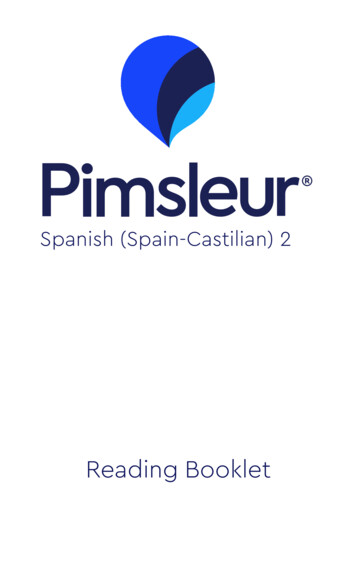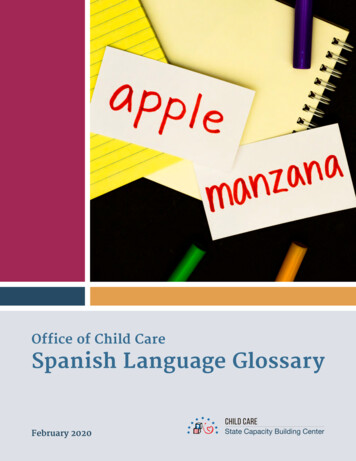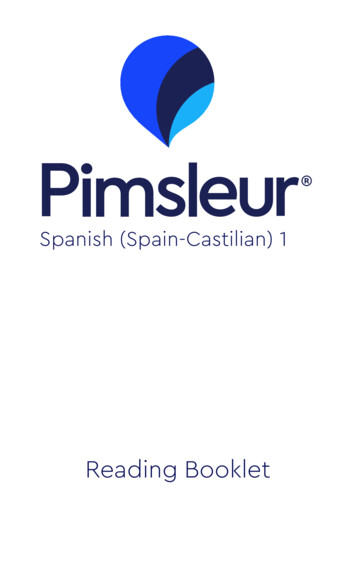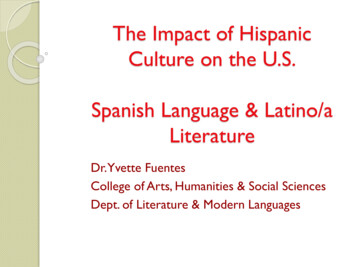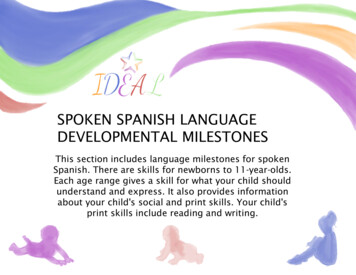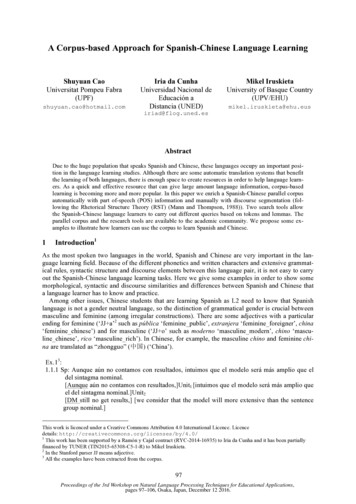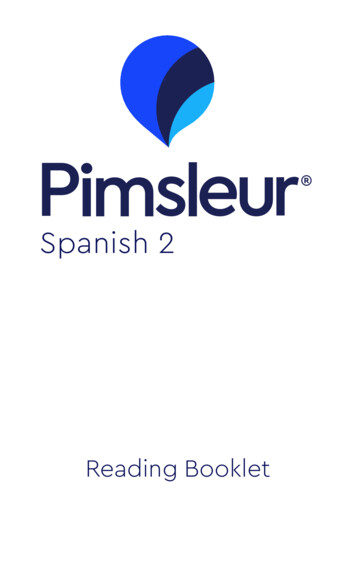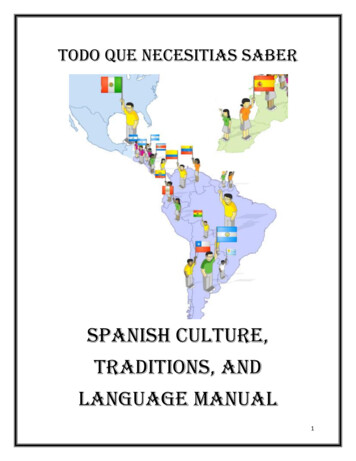
Transcription
Todo Que Necesitias SaberSPANISH CULTURE,TRADITIONS, ANDLANGUAGE MANUAL1
TABLE OF CONTENTSIntroduction to Spanish. 3International Population.4Geographical Distribution of the Language.7History of the Spanish Language.9Spanish Society and Culture.12Cultural Do’s and Don’ts.14Traditions- Dance, Music, Festivals, Food, Customs.16Most Common Spanish Dialects.20Phonology of Spanish.23Syntax of Spanish.24Morphology of Spanish.25Semantics of Spanish.26Pragmatics of Spanish.26Aspects of Language for Linguistic Transfer.27Checklist for Characteristics of Spanish-Influenced English.29Instrumental Assessment Tests.30Therapy Materials.32Resources for Therapy Ideas.32Videos, Readings and Related Materials.33Local and International Speech-Language Pathologists.37References.41Appendices.422
SpanishAlternate Names & Spellings: Español, Castellano, CastilianLanguage Family: Indo-European, Italic, Romance, Italo-Western, Western, Gallo-Iberian,Ibero-Romance, West Iberian, CastilianOfficial Language of: Panama, Uruguay, Venezuela, Mexico, Nicaragua, Paraguay, Peru,Puerto Rico, Spain, Argentina, Bolivia, Chile, Colombia, Costa Rica, Cuba, DominicanRepublic, Ecuador, El Salvador, Equatorial Guinea, Guatemala, HondurasAlso Spoken In: United StatesSpoken by Approximately: 322,299,000 people(Retrieved from Accredited Language Services, 2010)3
International PopulationAccording the US Census Bureau, results from the 2006 American Community Surveyindicated that, as of July 1, 2006, the following population data was recorded in regards tothe Hispanic population in the USA: 44.3 million Hispanics—14.8% of the total population (299 million)Hispanics accounted for one-half of the nation‘s growthHispanic growth rate (24.3 %) was more than three times the growth rate of the totalpopulation (6.1%)In the U.S., Spanish has a long history in the United States (many southern states were partof Mexico and Spain) and it recently has been revitalized by much immigration from LatinAmerica. Spanish is the most widely taught foreign language in the country. Although theU.S. has no formally designated "official languages", Spanish is formally recognized at thestate level, beside English; in the U.S. state of New Mexico 30 per cent of the populationspeak it. Spanish is the dominant spoken language in Puerto Rico. In total, the U.S. has theworld's fifth-largest Spanish-speaking population.Table 1 displays the type of origin, population size and percentage of the Hispanic populationin the USA (US Census Bureau, 2006):Table 1Country of OriginTotalMexicanPuerto RicanCubanDominicanCentral America *South America Other Hispanic * NumberPercentage44, 252, 278100.028, 339, 907.62,421,2975.53,394,0897.7* Refer to Table 2; Refer to Table 3; * Refer to Table 4As indicated by the data, the highest populations of Hispanics in the United States are fromMexico followed by Puerto Rica, and Central America. To further explore the Hispanicpopulation from the countries of Central and South America, Table 2 and Table 3 indicatesthe breakdown of the population from each country in the United States.4
According to the U.S. Census Bureau 2000, Table 2 displays a breakdown of the country oforigin for individuals of Central American decent in the United States:Table 2PopulationCountryEl SalvadorGuatemalaHondurasNicaraguaPanamaCosta RicaOther Central America817, 336480, 665282, 852220, 335105, 17771, 87047, 915Percentage of CentralAmerican population40.323.714.010.95.23.52.4According to the U.S. Census Bureau 2000, Table 3 illustrates the country of origin of theSouth American population in the United States:Table 3PopulationCountryPercentage of SouthAmerican PopulationColombia470, uayParaguay360, 559233, 926100, 86491, 50768, 84942, 06818, 8048, 769261776.5531.3.06According to the U.S. Census Bureau 2000, Table 4 demonstrates the country of origin ofthe population people classified under the title of other Hispanics. Table 4 represents thecountries of origin of individuals classified under other Hispanic. Individuals classified underother Hispanic are any response collected by the U.S. Census that the following categorieswere selected (Hispanic Not Specified, Spaniard, etc).Table 4CountrySpainEquatorial GuineaEaster Island - PolynesiaOtherPopulation299, 948Not specifiedNot specifiedNot specified5
The following tables represent the highest population of Hispanics in the United States, rankedby state, county and region (US Census Bureau, 2006).12345Top Five States by Hispanic Population Size: 2006StatePopulation SizeCalifornia13, 073, 156Texas8, 385, 139Florida3, 646, 499New York3, 139, 456Illinois1, 886, 93312345Top Five Counties by Hispanic Population Size: 2006CountyPopulation SizeLos Angeles County, CA4, 706, 994Harris County, TX1, 484, 311Miami-Dade County, FL1, 471, 709Cook County, IL1, 200, 957Maricopa County, AZ1,129, 5561234Hispanic Population by Region: 2006RegionPopulation SizeWest18, 864, 823South15, 373, 215Northeast6, 102, 314Midwest3, 977, 686RankRankRank6
Geographical Distribution of the Language:Spanish-speaking Countries by ntinaUnited can RepublicBoliviaHondurasEl SalvadorParaguayNicaraguaCosta RicaPuerto RicoPanamaUruguayJamaicaTrinidad and TobagoEquatorial GuineaWestern nt numbers of the populations of these countries speak Spanish7
Culture8
History of the Spanish LanguageThe Spanish language originated in the Southwest region of Europe known as the IberianPeninsula. Sometime before the end of the 6th century BC, the region's first inhabitants, theIberians, began to mingle with the Celts, a nomadic people from central Europe. The twogroups formed a people called the Celtiberians, speaking a form of Celtic.Under Roman rule, in 19 BC, the region became known as Hispania, and its inhabitantslearned Latin from Roman traders, settlers, administrators, and soldiers. When the classicalLatin of the educated Roman classes mixed with the pre-Roman languages of the Iberians,Celts, and Carthaginians, a language called Vulgar Latin appeared. It followed the basicmodels of Latin but borrowed and added words from the other languages.Even after the Visigoths, Germanic tribes of Eastern Europe, invaded Hispania in the AD400s, Latin remained the official language of government and culture until about AD 719,when Arabic-speaking Islamic groups from Northern Africa called Moors completed theirconquest of the region. Arabic and a related dialect called Mozarabic came to be widelyspoken in Islamic Spain except in a few remote Christian kingdoms in the North such asAsturias, where Vulgar Latin survived.During the succeeding centuries, the Christiankingdoms gradually reconquered MoorishSpain, retaking the country linguistically as wellas politically, militarily, and culturally. As theChristians moved South, their Vulgar Latindialects became dominant. In particular,Castilian, a dialect that originated on theNorthern Central plains, was carried intoSouthern and Eastern regions.(Retrieved from Accredited Language Services, 2010)Castilian & AndalusiaThe resulting language was a hybrid because Castilian borrowed many words fromMozarabic, and modern Spanish has an estimated 4,000 words with Arabic roots.The creation of a standardized Spanish language based on the Castilian dialect began in the1200s with King Alfonso X, who was called the Learned King of Castile and Leon. He and hiscourt of scholars adopted the city of Toledo, a cultural center in the central highlands, as thebase of their activities. There, scholars wrote original works in Castilian and translatedhistories, chronicles, and scientific, legal, and literary works from other languages(principally Latin, Greek, and Arabic). Indeed, this historic effort of translation was a majorvehicle for the dissemination of knowledge throughout ancient Western Europe. Alfonso Xalso adopted Castilian for administrative work and all official documents and decrees.9
The Castilian dialect of Spanish gained wider acceptance during the reign of the Catholicmonarchs Isabella of Castile and Ferdinand of Aragon, who completed the reconquest ofSpain in 1492 by pushing the Moors from their last stronghold in the southern city ofGranada. Isabella and Ferdinand made Castilian the official dialect in their kingdom. In thesame year the Moors were defeated, an important book appeared: Antonio de Nebrija's Artede la lengua castellana (The Art of the Castilian Language). It was the first book to study andattempt to define the grammar of a European language.The Castilian dialect of Toledo became the written and educational standard in Spain, eventhough several spoken dialects remained. The most noteworthy was Andalusian, a dialectspoken in the southern city of Seville in the Andaluca region.(Retrieved from Accredited Language Services, 2010)Spanish around the WorldSpanish in the AmericasBeginning in the 1400s, Spanish explorers, conquistadors, andcolonizers carried their language to Central America, SouthAmerica, and parts of North America.Both the Castilian and Andalusian dialects made the trip. Castilianwas used in administrative and cultural centers such as MexicoCity, Mexico; Potosí, Bolivia; and Lima, Peru. These cities retainedclose links to the Spanish capital of Madrid, which was in theCastile region. But because many of the people involved in expeditions were from Andalucía,the Andalusian dialect also traveled to the Spanish colonies. It became dominant inArgentina and Central America, which were regions remote from the influence of the Spanishgovernment's administrative centers. Spain lost control of its American colonies in the1800s, but the Spanish language remained and is now the official language of almost everyLatin American nation.The Spanish spoken in the Americas differs somewhat from European Spanish todaybecause many words were borrowed from the languages of the indigenous peoples. Most ofthese words reflect features unique to the new territories, such as proper names, plants andanimals, and geographic features.(Retrieved from Accredited Language Services, 2010)10
Spanish Language in the United StatesIn 1565 Spanish conquerors and explorers established thesettlement of Saint Augustine in what is now Florida. It was thefirst permanent European settlement in what is now the UnitedStates. In the 1600s and 1700s Spanish explorations andsettlements extended the Spanish language North from Mexicointo present-day Arizona, California, Southern Colorado, New Mexico, and Texas. When theUnited States annexed these areas following the Mexican War (1846-1848), many of theregion's Spanish-speaking inhabitants remained, creating a distinct linguistic and culturalpopulation in the Southwestern United States.After the Spanish-American War (1898), the United States gained control over Cuba, Guam,the Philippines, and Puerto Rico. Over time, many Spanish speakers from these countriesmoved to the mainland of North America. The immigrants primarily settled in neighborhoodsin California, Florida, New York, and New Jersey, where they continued to use Spanish.Immigration by Spanish speakers further increased during the 20th century. Many legal andillegal immigrants crossed the border between Mexico and the United States to work inagriculture and industry, and other immigrants fled political instability in Chile, Cuba, ElSalvador, Guatemala, and Nicaragua. Also, many Latin American students came to NorthAmerica to study at colleges and universities.The presence of Spanish in American culture grew throughout the late 20th century. Asmore native Spanish speakers sent their children to school, elementary and high schoolsestablished bilingual classes. Television executives also recognized the Spanish-speakingmarket and created television networks and shows in Spanish. The government printedforms and tests in Spanish. By the 1990s more than 17 million people in the United Statesspoke Spanish as their primary language at home.Spanish Language in the PhilippinesIn the Philippines, which were incorporated into theSpanish Empire in the mid-16th century, Spanish servedas the language of the ruling class, of civil and judicialadministration, and of culture. Because Mexico oftenmediated communication between the Philippines andSpain, Philippine Spanish in general is similar to theCastilian dialect used in Mexico. In 1898, at theconclusion of the Spanish-American war, Spain ceded the Philippines to the United States.For many years afterwards, Spanish was one of the official languages of the Philippines,along with English and Tagalog. Today, Spanish is no longer an official language, and itsusage has gradually declined.(Retrieved from Accredited Language Services, 2010)11
Spanish Society & CultureSpanish Family Values The family is the basis of the social structure and includes both the nuclear andthe extended family, which sometimes provides both a social and a financial supportnetwork.Today, it is less common than previously for family members to work in a familybusiness, as personal preferences are important and university education is general.The structure and the size of the family vary, but generally, people live until longerlives, have fewer children than before, and fewer people live in their homes withextended family.Familial networks have become less tight. The greatest changes have occurred insidefamilies, between men and woman, and the parents and children because the valuesthat inspire these relations have changed.Machismo Machismo is the word for male dominance, and the culture of old men who created ithas changed dramatically.Religion The majority of Spaniards are formally Roman Catholic, although different religiousbeliefs are accepted.During the history of Spain, there have been long periods of where different religiousgroups have coexisted, including Muslims, Jews and Christians.Still some traditions manifest more like a cultural event than a religious one. DuringHoly Week, many participants of the processions wear peaked, black hats as the signof a penitent and walk barefoot, carrying a burden of some kind.Religious history is apparent in every small town, where the most grandiose buildingis typically the church. In the large cities the Cathedrals are almost museums.Meeting Etiquette When introduced expect to shake hands.Once a relationship is established, men may embrace and pat each other on theshoulder.Female friends kiss each other on both cheeks, starting with the left.People are often referred to as Don or Dona and their first name when in formaloccasion as a general rule.Many men use a two-handed shake where the left hand is placed on the rightforearm of the other person.12
Relationships & Communication The Spanish prefer to do business with those they know and trust.It is important that you spend sufficient time letting your business colleagues get toknow you.Face-to-face contact is preferred to written or telephone communication.The way you present yourself is of critical importance when dealing with Spaniards.It is best to display modesty when describing your achievements andaccomplishments.Communication is formal and follows rules of protocol.Avoid confrontation if at all possible. Spaniards do not like to publicly admit that theyare incorrect.Trust and personal relationships are the cornerstone of business.Spaniards, like many societies, are concerned that they look good in the eyes ofothers and try to avoid looking foolish at all times.Business Meeting Etiquette Appointments are mandatory and should be made in advance, preferably bytelephone or fax. Reconfirm in writing or by telephone the week before.You should try to arrive on time for meetings.The first meeting is generally formal and is used to get to know each other. Do not besurprised if no business is actually conducted during the first meeting.Agendas are often used but not always needed to be followed too strict.Make sure all your printed material is available in both English and Spanish.Not all businesspeople speak English, so it is wise to check if you should hire aninterpreter.Most Spaniards do not give their opinion at meetings. Therefore, it is important towatch their non-verbal communication.Dress Etiquette Business dress is stylish yet, conservative.Elegant accessories are important for both men and women(Retrieved from Kwintessential, 2010)13
Cultural Do’s and Don’ts with CentralAmericans--El Salvador, Guatemala, MexicoCultural Do’s:1.2.3.4.5.6.7.8.9.10.Communicate in an indirect style.Take time to develop personal relationships.Be aware time is flexible.Emphasize and build trust.Be friendly in business dealings.Recognize that physical contact is common with conversing.Know that, generally, Latin Americans stand relatively close during conversation.Acknowledge official titles.Give clear instructions and directions.Make an effort to understand Central American cultural values.Cultural Don’ts:1.2.3.4.5.6.7.8.9.10.Be too direct or aggressive.Do business without first establishing a personal rapport.Embarrass anyone in front of others.Ask ―yes‖ or ―no‖ questions (if it can be avoided).Pull away in conversation because of someone standing too close.Ignore the importance of status.Opine of Central American/US political issues.Expect your authority to be challenged, even when you‘re wrong.Assume that ―yes‖ always means ―yes‖.Be afraid to learn some Spanish words and phrases.(Retrieved from English League, 2010)14
Traditions15
Spanish DanceThe concept of Spanish dance immediately conjures up images of the strumming guitars,stomping feet and bright dresses of flamenco. While many people make this commonconnection between Spain and flamenco, a plethora of traditional dances from Spain'svarious regions weave into the lengthy history of Spanish dance. For example, not manypeople would ever expect to visit Spain and hear the music of bagpipes and tambourinesfloating through the air, yet it is the traditional music accompanying Spanish dance acrossnorthern Spain!For almost as long as man has existed he has used dance as a form of communication andpersonal expression. Spain is certainly no exception. Ritualistic dances commemoratingbattles and other war-related themes were the first to appear, and centuries later during theMiddle Ages, structured religious-themed ritual dances were recognizable.During the Baroque period, gypsies arrived to the Iberian continent and the growingpopularity of the gypsy music and dance, flamenco, eagerly formed part of the history ofSpanish dance. The rest is history- or rather Spanish dance history- as flamenco has sincebecome both a national and international sensation.(Retrieved from Enforex, 2010)Traditional Spanish DancesJota Aragonesa: This typical dance hails from the north of Spain, namely Aragón,and features a fast tempo as couples dance with their hands raised high above theirheads playing castanets. Moorish influences are probable, as it is loosely attributed to aMoorish poet who was kicked out of Valencia during the 12th century.Sardana: Several couples join hands and dance in a closed circle in this traditionaldance from Catalonia.16
Muñeira: Danced in twos or alone along to the music of bagpipes, this traditional"Miller's Dance" is typical throughout Galicia and Asturias.Zambra: The zambra began as a Moorish dance, but with monarchs Fernando andIsabel's reconquista of Spain, the Moors were able to conserve the dance by adaptingit to Spanish dance customs.Bolero: One of the oldest and most traditional dances of the history of Spanish dance,the bolero is a quick Spanish dance boasting sudden pauses and sharp turns.Fandango: At one point the most famous dance of Spain, the fandango is a lively,happy Spanish danced in two's.Paso doble: A quick one-step Spanish dance.Flamenco: A passionate dance hailing from gypsies, flamenco is internationallyfamous. Learn more!Sevillana: Lively and joyous dance typical of Seville and reminiscent of flamencothat features four distinct parts.(Retrieved from Enforex, 2010)Spanish MusicFrom the typical music of bagpipes echoing throughout the northern region of Galicia to thefeisty strumming of the flamenco guitar in Andalucía, Spanish music is truly one of the highpoints of Spain‘s resplendent culture. Traditional music spanning centuries along withpopular singers tearing up the charts today put Spanish music in a category of its own.(Retrieved from Enforex, 2010)17
Spanish FestivalsWinter, spring, summer or fall, your travels in Spain are sure to coincide with at least one ofthe many Spanish festivals filling up Spain's jam-packed cultural calendar. Spaniards aremasters within the universe of celebrations and festivals, and a trip to Spain will quicklyshow you just that.From Sevilla's joyous Feria de Abril to the chaotic Running of the Bulls in Pamplona, Spanishfestivals range from regional to national, from one day to entire weeks, from festive partyingto solemn processions, and everything in between.These festivals provide visitors with a wonderful display of traditions and culture. What'smore, our Enforex schools, located in Spain's most culture-packed cities, are open all yearround; that way you can learn Spanish while experiencing incredible Spanish festivals!The chaotic running of the bulls, or el encierro, is the most characteristic and internationallyrenowned part of the sanfermines. The running of the bulls takes place everyday at eight in18
the morning and consists of a crowd of primarily young men who run ahead of the clamoringbulls through an 830-meter stretch of cobbled road and into the city s bullring. After eachmorning is greeted with the daily Running of the Bulls, bullfights liven up each afternoon,and parades featuring bands of music and enormous giants constantly wind through thestreets. On July 7th, a procession dating back to the 13th century boasts music andenormous crowds as it passes through Pamplona in honor of San Fermín.(Retrieved from Enforex, 2010)Geography of Spanish FoodsThe basis of the history of Spanish food of course has to do with its geographical situation.First of all, the country is located on the Iberian peninsula and is therefore almost entirelysurrounded by the waters. Naturally, due to this fortunate location, seafood forms one of thepillars of Spain's gastronomy and categorizes the country as having a Mediterranean diet.The rest of Spain is a diverse terrain made up of mountain ranges, lush pastures, fertilefarmgrounds, extensive coastlines and more, which together provide quite the variety offresh products. For example, Spain's famous hams are cured high in the mountains,vineyards and olive groves sprawl across expanses of land, and fresh fruits and vegetableshail from throughout the country.(Retrieved from Enforex, 2010)Spanish Eating Customs: MealsA normal day's breakfast- or desayuno- typically consists merely of a cup of coffee, althoughit's also commonplace to accompany your steaming café con leche with a croissant or otherpastry. While an American traditional breakfast has pancakes, bacon, and eggs, the Spanish"traditional" breakfast consists of the vastly popular churros, served sprinkled with sugar ordunked in hot chocolate.Spaniards eat their lunch, or comida, between 2:00 and 4:00 in the afternoon. Serving asthe day's main meal, it is traditionally quite a bit larger than the dinner meal, or cena. Atypical lunch will have several courses. The first course is the lighter part of the meal, usuallyconsisting of a salad or soup, while the second course is normally your typical fish or meatdish. A dessert can be a simple piece of fruit, a typical Spanish flan, or a sweet pastry orcake.While there are of course many people who eat full meals, the Spanish dinner (cena) istraditionally much smaller than the midday comida. It often consisting of something lighterlike a salad, a sandwich, or a selection of tapas. Spaniards eat late for this final meal of theday- even more so on weekends and during the summer- sitting down to eat anytime from9:00 until 11:00 in the evening(Retrieved from Enforex, 2010)19
Spanish Eating Customs: SiestaNo, it's not a myth. Yes, the infamous siesta really does exist. It began long ago as aftereating the large mid-day meal farmworkers needed to rest and digest before going back outto work the fields. While this daily break doesn't necessarily include a nap, businesses andstores do shut down for about two hours and many people return home to eat with theirfamilies.(Retrieved from Enforex, 2010)Authentic Spanish Recipes can be found in the appendixMost Common Spanish DialectsSpanish is not a homogenous language. As a result of centuries of evolution across theworld, nearly every Spanish-speaking country has its own dialect.Neutral SpanishThis dialect uses generic terms to avoid colloquialisms and potentially offensive language. Italso includes some verb tenses that have disappeared from other varieties of Spanish. Theresult is a dialect that can be understood by almost all Spanish-speakers.When to use:This is the most universally recognized variant of the Spanish language. Translatedocuments into Neutral Spanish when the material will be used across many Spanishspeaking countries and your budget doesn‘t permit tailored translations.Also known as:Standard Spanish, Global Spanish, or Universal SpanishCastilian SpanishFrom the region of Castile, this dialect became the language of a unified Spain. The RealAcademia Española (Royal Spanish Academy) upholds the purity of this dialect.When to use:This is the variant of Spanish used in Spain and should be used for all documentsintended for that country.20
Can also refer to:The dialect of North-Central Spain, as opposed to Spanish dialects spoken in otherregions of Spain (ex. Andalusian in the South).Standard Spanish (see above).Latin American SpanishThis includes all of the Spanish language dialects found throughout Latin America. Thesevary in grammar, idiomatic expressions, and vocabulary from Castilian Spanish and fromeach other. These dialects particularly differ from European Spanish in the use of loan wordsfrom English (i.e. email instead of correo electrónico).When to use:For documents that will be used in a particular Latin American country, be sure tolocalize your translation to the proper Spanish dialect.United States SpanishAn estimated 70% of Hispanic households in the United States speak Spanish at home. Thisincludes immigrants and descendents of immigrants from every Latin American country,resulting in a complex mix of dialects and cultures. For example, the Spanish spoken in NewYork City often has a Puerto Rican influence, while the Spanish in Los Angeles is closer tothat spoken in Mexico.When to use:Translating documents to be understood by Spanish-speakers in the United Statestaps into a large potential market. It also poses its own set of challenges. Considerwhich market you are targeting and tailor your translation accordingly.(Foreign Translations, 2010)21
Language22
Spanish LanguagePhonology:There are many similarities in the phonologies of English and Spanish (Bilinguistics, 2007).Both English and Spanish use the same alphabet; however the Spanish sound system ismore concise (Bilinguistics, 2007). There are 18 consonant and 5 vowel phonemes inSpanish (Goldstein, 1996). A number of consonants have associated allophonic variations.For example, the voiced /b, d, g/ become the voiced spirants (B as in bebe, th as in dado, gas in delgado) in certain linguistic environments typically intervocalicly. Acceptableconsonant clusters are /pl, pɾ, bl, bɾ, tɾ, dɾ, kl, kɾ, gl, gɾ, fl, fɾ/, and only five singletonconsonants can appear in the final-word position: /l, ɾ, d, n, s/ (Goldstein, 1996). Comparedto the phonology in English, Spanish phonology does not contain the English glottal /‘/, thevoiced affricate /ʤ/ (judge), the voiced /ð/ and unvoiced /θ/ (thigh, thy), the voiced /ž/ andunvoiced /ʃ/ (azure, shy), the /z/, the /ŋ/ (sing), and the flap /ɾ/ (as in butter) (Bilinguistics,2007). The following table illustrates the Spanish sound system.Spanish phonology contains five vowels and 13 diphthongs. The Spanish vowels consist of/a/ as in cart/casa, /e/ as in pet/ pepe, /i/ as in tea/si, /o/ as in no/yo, /u/ as in guru/uno.The following chart illustrates the Spanish vowels (Athabasca University, 2010):23
Spanish has 13 diphthongs with six falling diphthongs (i.e. stress is low to high) and eightrising diphthongs (i.e. stress is high to low). The following chart displays the 13 diphthongsfound in the Spanish l
Spanish Language in the United States In 1565 Spanish conquerors and explorers established the settlement of Saint Augustine in what is now Florida. It was the first permanent European settlement in what is now the United States. In the 1600s and 1700s Spanish explorations and settlements extende
